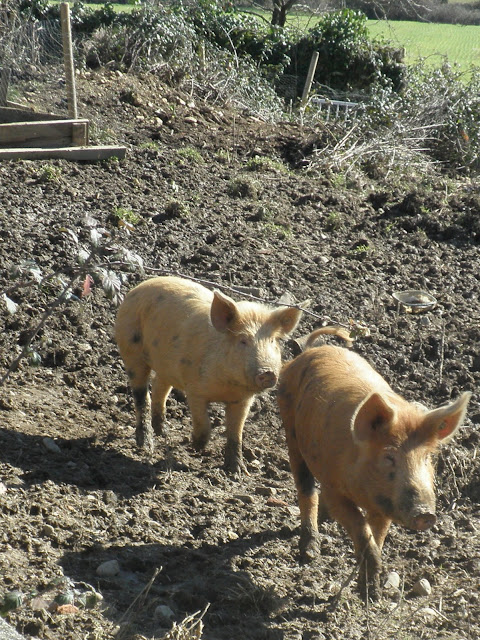Friends have a couple of pigs. They’ve plunged into life in France head-first; a tumbledown, do-er-up-er farm house in the middle of nowhere; kids, chickens, veg plot, pigs. It’s good to have a challenge...
I’ve volunteered to help them dispose of the bodies – I’ve
spent three years as a charcutier
after all.
I don’t have a clue what I’m doing...
Tuer le cochon is
an old fashioned winter tradition that is still prevalent in this neck of the
woods – I dare say all over rural France – though it does appear to be on the
wane. I come across plenty of people whose parents do it, or used to, but I’ve
never yet found anyone in the position to show me the ropes. Hence my problem –
what the fuck am I going to do with two
whole dead pigs?!
Mercifully (perhaps not for the animals themselves) they’re
not too big. Though not till arrival at the abattoir do I discover quite how
youthful they are. There’s a queue of trailers waiting in line for the one day
in the week allotted to amateurs like
us. I’m shocked at the size of the other piggies. Not little. More like pink
cows. The uncomfortable truth about meat eating is fairly unavoidable at a
place like this, but I feel bad because our pigs are so small – though not much younger than a butcher’s cochon. It seems a shame to not let them
carry on their happy life, scoffing acorns and chestnuts, rolling in mud,
steering clear, with luck, of the neighbour’s petunias. Another six or eight months
seems wisest...
Reality bites; the decision is made. It’s the end of the
winter and this year’s opportunity to butcher hygienically without a walk-in
fridge is about to close. This, along with the pigs’ proclivity for escapology,
plus the financial pressures of my friends’ growing family, means their time is
nigh. They were bought to feed the family. They have to be killed sometime, and
that’s dictated by what best suits man – not beast.
I collect them two days later. Here the disparity between my
cargo and others is even more glaring. One man covers the entire floor of his
van with a single carcass, split in two lengthways. My two piggies fit in the
back of our Fiesta... The abattoir has done a sterling job: I take home meat. The uncomfortableness of death fades with the
familiar appearance of my load. I’m already looking forward to dinner.
 There’s no rain so we work outside. Winter has kept its side
of the bargain – though it’s hard to say the weather’s been kind. Working with
bare hands at 2 degrees is more than a little nipsville. Healthy, mind. And the
beer’s nicely chilled! Without the guiding hand of a butcher or experienced pig
weekendeur, we turn to our only
reliable alternative: youtube. Hugh Fearnley-Whittingstall, or rather his
butcher friend Ray Smith and their Pig in a Day video* do us proud. Not as romantic as a pinard-guzzling, be-bereted
campagnard showing us his
grandfather’s tricks, but you can’t have it all. Maybe next year...In spite of
our lack of heritage, breaking the carcasses down into constituent parts is
really quite straightforward. Well done us!
There’s no rain so we work outside. Winter has kept its side
of the bargain – though it’s hard to say the weather’s been kind. Working with
bare hands at 2 degrees is more than a little nipsville. Healthy, mind. And the
beer’s nicely chilled! Without the guiding hand of a butcher or experienced pig
weekendeur, we turn to our only
reliable alternative: youtube. Hugh Fearnley-Whittingstall, or rather his
butcher friend Ray Smith and their Pig in a Day video* do us proud. Not as romantic as a pinard-guzzling, be-bereted
campagnard showing us his
grandfather’s tricks, but you can’t have it all. Maybe next year...In spite of
our lack of heritage, breaking the carcasses down into constituent parts is
really quite straightforward. Well done us! |
| It did get a little nippy... |
A lot of the meat is destined for the freezer, to feed my
friends’ family for the best part of the year. Some goes into brine to make
country-style boiling hams, or a dry cure for bacon. We judge the legs too small and lean to bother air
drying. A pity, but also a relief. While undoubtedly spectacular, this is the most
precarious means of preserving such a precious home-grown commodity*. The rest
goes towards sausages, confit, paté and rather a mean pork pie! Not forgetting
black pudding – I am not a completely useless charcutier and, if there is one thing I have learnt to love making
above all others, it is this. Frugal, a bit stinky and very messy in the making
(combining the head, the heart, the lungs and the blood and guts with some
simple veg and spices), the Boudin Noir Béarnais is as glorious a tribute to the noble piggy-wig and his patient
keeper as I could choose.










































.JPG)





